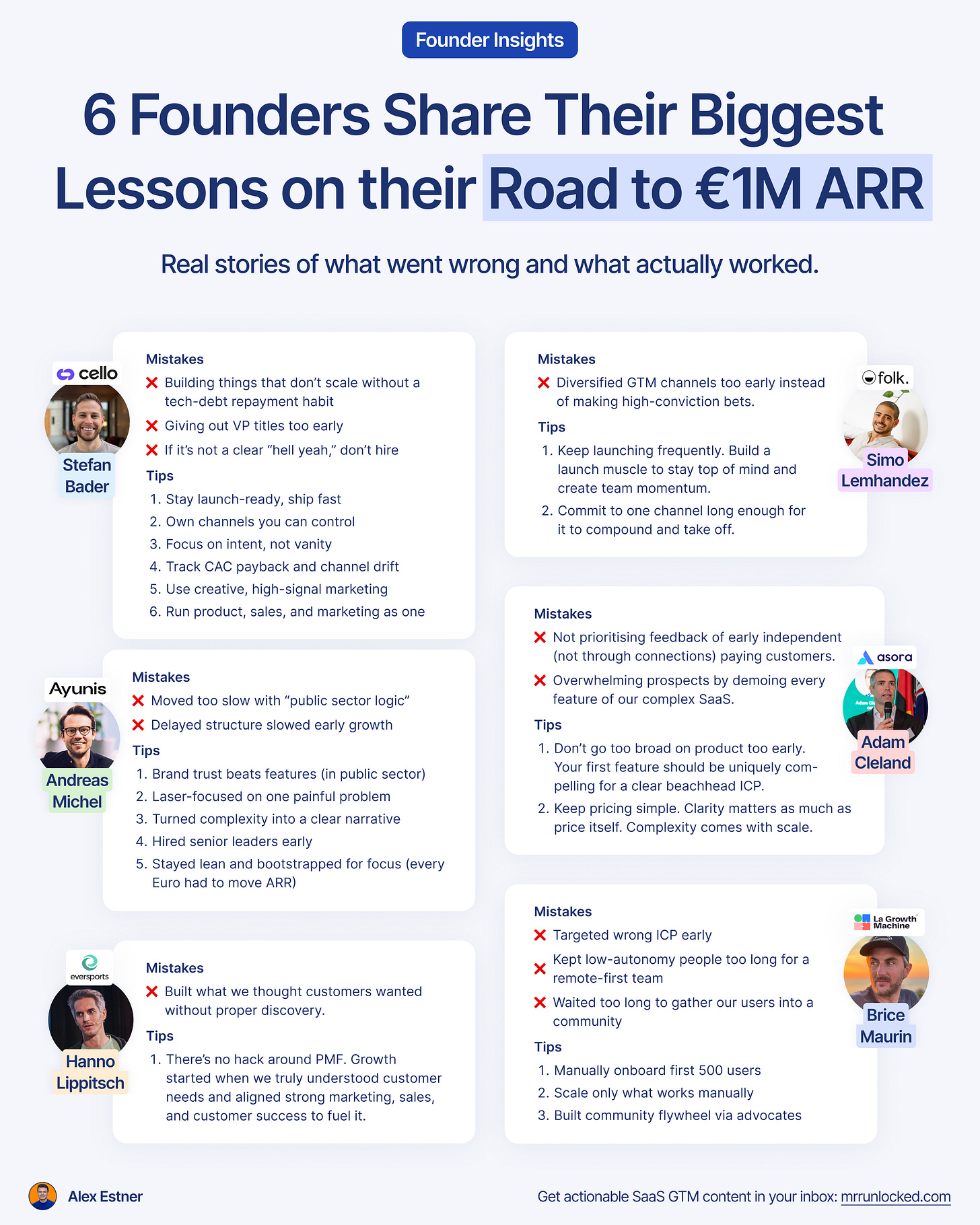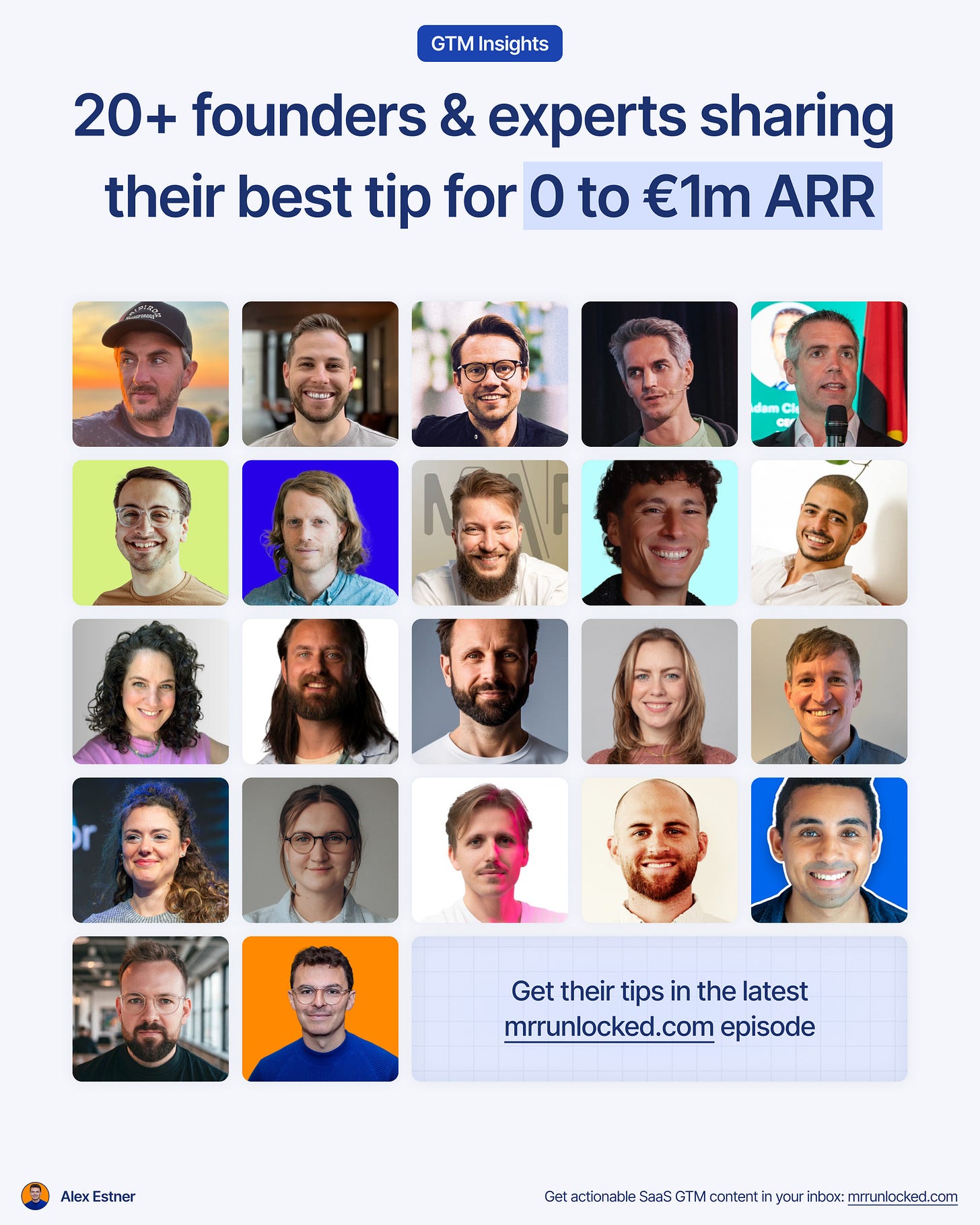6 founders sharing their mistakes & tips going from 0-1
Real stories of what went wrong and what actually worked
Hey - it’s Alex!
This is a very special edition of the newsletter because this time, we are bringing together insights from multiple founders and experts who have been there, done that, and are now excited to share their learnings with you!
It’s a 2-part newsletter series:
👉 Part 1 (today): 6 founders sharing their mistakes & tips
👉 Part 2 (next episode): 15 experts sharing what works today and 2026
In case you missed the last 3 episodes:
✅ Why pitches fail (+ fix yours in 11 slides)
✅ 6 GTM tactics that work surprisingly well for bootstrapped founders
✅ 9 GTM infographics to hit your 1€ million ARR
GTM Foundation Library
If you want to grow your SaaS to the 1€ million ARR, I’ve created my free GTM library with 50+ Infographics for you.
👉 Reach 25.000+ SaaS operators with sponsored content. Sponsor the next newsletter..
Founder Insights: What went wrong and what worked
Let’s hear it from the founders who have successfully scaled their company from €0 to the 1€ million ARR and beyond.
Learnings from 6 founders
👉 Stefan Bader: Co-Founder of Cello (Referral Software for SaaS)
👉 Andreas Michel: Co-Founder of Ayunis (Software for municipalities)
👉 Hanno Lippitsch: Co-Founder of Eversports (Software for sports venues)
👉 Simo Lemhandez: Co-Founder of Folk CRM (The next gen of CRM)
👉 Adam Cleland: Founder of Asora (Software for modern family offices)
👉 Brice Maurin: Founder of LGM (Software for Multi-Channel Outbound)
I asked each founder to share:
1️⃣ The painful mistake(s) they made in the 0-1 stage (that others should not make)
2️⃣ The best tips/things that worked for them.
Okay, let’s go 👇.
#1 Stefan Bader - CEO, Cello
1) Mistakes
❌ Building things that don’t scale without a tech-debt repayment habit
In the early days, it’s fine to build scrappily and prioritise speed over clean architecture. However, paying down tech debt must become a continuous habit; otherwise, you will eventually trap yourself in a system that slows you down instead of enabling you. We had to learn this and work our way back out.
❌ Title game: Giving out VP titles too early.
At this stage, everyone should be an IC. You have C-level + Senior/Lead/Head is fine, but avoid VP because it creates the wrong expectations and limits flexibility later. Yes, we learned from our mistake.
❌ Being ruthless at hiring: If it’s not a clear “hell yeah,” don’t hire.
Early hires shape culture disproportionately - compromising here slows you down and creates clean-up work later. Retrospectively, the most expensive mistakes we made were related to this.
2) Hacks / Tips
✅ Don’t entirely build your GTM on rented land
When platforms move the goalposts, visibility collapses overnight. Make sure you own some of your channels -> referrals, communities, integrations
✅ Signal > noise - Low-signal volume kills conversion
Build intent-based outbound that gives AEs real buying context - not vanity metrics.
✅ Measure Product–Channel Fit like Product–Market Fit
Even great products fail if their channels collapse. Track CAC payback and conversion drift - they can be early warning signs.
✅ Practice subversive marketing - Break out of the mainstream.
Surprise your market with creative, high-signal plays that challenge expectations and earn organic attention. Make sure you always create value first for your target audience.
✅ Stay launch-ready
Channels degrade faster than most teams react. Build a launch muscle: ship, test, rebuild - fast.
✅ Collapse silos early
Product, sales, and marketing should run as one GTM system. Fragmented teams can’t adapt when channels shift.
#2 Brice Maurin - CEO, La Growth Machine
1) Mistakes
❌ Desktop app slowed adoption
Building a desktop app that users had to install, which created IT friction and slowed adoption, that’s why LGM is now fully web-based.
❌ Bad onboarding UX
Accepting an ugly but “working” V1 onboarding, it technically worked, but we lost months we could’ve saved by improving UX earlier.
❌ Focus on the wrong ICP
Targeting the wrong ICP early on, chasing “growth hackers” focused on volume instead of people who care about getting real replies.
❌ Waited too long to gather our users into a community
Not rallying a core group of early users from day one with a real community-building strategy, whether for referral (marketing) or co-creating the product roadmap.
❌ Underestimated localization efforts
Underestimating time zone needs when expanding to the US can lead to rapid growth stalls without a local presence or support.
❌ Kept low-autonomy people too long for a remote-first team.
Protecting team cohesion matters more than short-term output.
2) Hacks / Tips
✅ Manual onboarding of first customers
Ruthless filtering and manual onboarding of the first ~500 users, which led to high signal, low churn, and real co-building with customers.
✅ Scaling only what works manually
Do manual stuff first. If it works, scale it. For our outbound, mixing channels (email, LinkedIn, X, calls, voice) worked great.
✅ An “integrations-first” GTM approach
25+ integrations opened new markets, especially in the US, thanks to partners’ distribution.
✅ Building a community flywheel
Create a community flywheel: Social listening, inviting advocates, and running a creator program that generated inbound momentum.
✅ Intent-based outreach
Engaging visitors and post-interactors matching our ICP, then triggering personalized LGM campaigns.
✅ Word of mouth
English-first product and YC startups’ word-of-mouth created a small loop with a massive compounding effect.
#3 Andreas Michel - Co-Founder & CEO, Ayunis
1) Mistakes
❌ Trying to move too slowly because of “public sector logic.”
We thought we had to play by their rules - long procurement cycles, formal sales, endless pilots. But in reality, the public sector moves faster when you give it something concrete and usable. Bureaucracy slows down thinking, not buying in general.
❌ Underestimating how early structure accelerates growth
We believed we could stay fully “startup-scrappy” longer - but scaling even a small public-sector SaaS requires clear roles, predictable ops, and professional processes much earlier than expected.
2) Hacks / Tips
✅ Brand trust > features
In the public sector, credibility and design beat long feature lists.
✅ Laser-focus on one real problem
We didn’t try to “digitize municipalities.” We just helped them manage facilities - one very painful process. From there, expansion became natural.
✅ Turn complexity into narrative
We didn’t just sell SaaS - we sold the story of modern administration. That’s how we have been transforming from one niche (sport facilities) to a platform (Ayunis).
✅ Hire seniors early
We hired people who could build structure and lead teams - even before we really “needed” them. It allowed us to grow faster later without breaking internally.
✅ Stay lean and bootstrapped
Scarcity forced focus. Every euro had to move ARR.
💡 P.S. How I helped Ayunis to become the leading public sector SaaS in D/A/CH.
#4 Hanno Lippitsch - CEO, Eversports
1) Mistake
❌ Building without enough customer research
To believe that you already know what customers want and basically build what you think they want without having had proper discovery meetings
2) Hack / Tip
✅ There is no hack to get around PMF
We started to accelerate when we reached PMF with the Studio Manager focusing mainly on Yoga Studios. Properly working with customers and truly understanding what they want, while having good commercial teams (Marketing, Sales, CC) in place, puts fuel in the fire.
#5 Simo Lemhandez - Co-Founder, folk CRM
Hacks / Tips
✅ Keep launching frequently
The biggest risk is not to launch too much, but rather to go unnoticed. It helps you build a launch muscle, find what resonates with your customers, and more broadly create momentum in your team!
✅ Don’t diversify go-to-market channels too much
What works is doing high conviction bets. Investing long enough in a channel until the channel can take off. Splitting your channels across multiple channels reduces your chances of finding go-to-market alpha.
Try for a few months at least. All channels tend to compound.
SEO results will take a few months to appear. You need to try to work with tens of influencers before that one goes viral. etc. So it’s a matter of choosing properly the channel you want to invest in in advance, and committing.
The goal here is to stay top of mind, to own a space in customers’ minds. A healthy launch routine is launching something every week, with a major launch every month.
#6 Adam Cleland - CEO, Asora
1) Mistakes
❌ We didn’t sufficiently prioritise the feedback of the early customers
When you start building, lots of stakeholders have an opinion on what you should do. Friends, family, investors, board advisors, internal team members, industry specialists, pilot customers, design partners, and others. You, as the founder!
We didn’t sufficiently prioritise the feedback of the early independent (not through connections) paying customers. Someone with a problem who didn’t know you and paid for it to be solved. Their feedback should be put on a pedestal, and finding those people is your number one priority.
❌ We overwhelmed our prospects by showing all features in our demos
We sell a quite complex SaaS solution, so we thought for too long that we had to demo all the features we have, leading to overwhelmed prospects. The key reason is that we haven’t done enough discovery.
2) Hacks / Tips
✅ Don’t go too broad on product strategy too early
Your initial TAM isn’t your ultimate TAM. Even if you’re building a broad platform or have a big vision, make sure you have one feature that’s truly compelling and differentiated for your beachhead ICP.
✅ Keep pricing clean and simple
Clean and simple can be as important as the overall pricing level. More mature companies’ pricing typically becomes complex.
💡 P.S. How I helped Asora 2,7x their MQLs and grow beyond 1€ million ARR
Now I want to hear your story
I hope you can learn a lot from their mistakes & tips.
👇 Respond to this email and share your mistakes & tips with me. I will feature the best ones in the upcoming episode.
Stay tuned for the next episode, where 15 experts are sharing their best tips with you.
Happy growth 🚀
3 ways I can help you grow your SaaS to €1 million ARR 👇
1️⃣ Use my free GTM library with 50+ free resources (guides, templates, workbooks, and tools) to build a strong GTM foundation (helped 5000+ SaaS leaders)
2️⃣ Get a 360° GTM audit of your status quo + a custom 6-month action plan
3️⃣ Work 1-on-1 with me - GTM Advisory for SaaS founders from €0 to €1 million ARR





